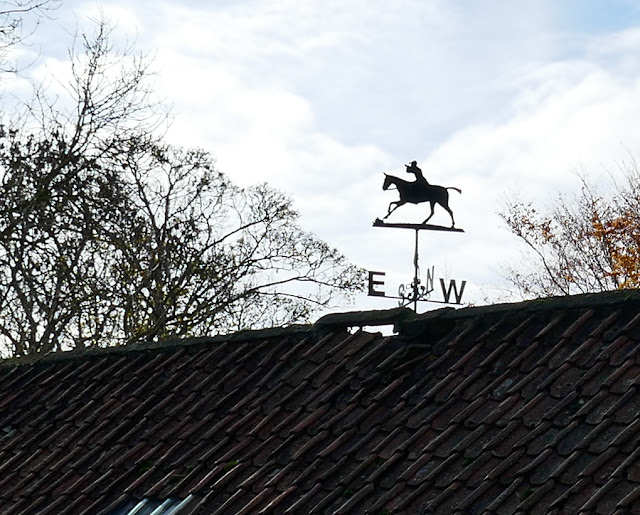Captain Cook Country from Great Ayton
8 miles Fine and dry
Tom Scott Burns remarks that Great Ayton was known as Canny Yatton and in the early 1800s was the haunt of Au'd Nanny, a notorious witch described in Blakeborough's dialect verse T' Hunt o' Yatton Brigg.
"Her naals they war lang, an' humped war her back,
An baith lugs war pointed, her skin ommaist black... "
Au'd Nanny is long gone and we parked on Great Ayton High Street near to Suggitt's Cafe and crossed the River Leven by the steel bridge opposite the cafe.
 |
| Today's walk from The Walker's Guide to the Cleveland Hills |
 |
| Great Ayton |
 |
| River Leven at Great Ayton |
This bridge was erected in June 1919 by The Ayton Mine Company in memory of five soldiers who died in WW1 and it has recently been given a facelift.
 |
| Recently fitted Remembrance panel on bridge |
After crossing the bridge we paused briefly to admire the old pissoir which has been located near the bridge as a non-operational feature and painted red for some reason. There were originally three of these and to my recollection they were painted a tasteful green.
 |
| The locked urinal |
Leaving the old urinal we looked at the waterfall and read a nearby notice board that tells of the flood of 1840, which caused much damage and destroyed the Fulling Mill at Kildale. We would visit the site of the old mill later during today's walk.
 |
| Waterfall Park |
 |
| Clive passes by the old sluice gate |
 |
| Walking along the banks of the River Leven |
Leaving Waterfall Park behind we followed field paths along the River Leven to soon reach Woodhouse Farm.
 |
| Leave the road at the stile |
It's quite a steep climb to reach the moor gate where we noticed the date 1668 carved into the stone gatepost.
 |
| '1668' and 'JW' |
 |
| Steep climb to the moor gate |
 |
| Flammulina Velutipes - winter mushrooms, grows on rotten wood |
 |
| Easby Hall below (zoom view) |
Reaching the Moor Gate we turned right to follow the path below the moor to Mill Bank Wood. Here we turned right again onto a permitted path, to descend to the river and the remains of the old mill. TSB says that the wood is actually named after an old Bleach Mill where woollen cloth was 'fulled' in order to soften and shrink it to a warmer, closer weave. The mill was destroyed on the night of 21st July 1840 when heavy rains caused enormous volumes of water to burst two fishponds at Kildale Hall. A wall of water 40 feet high carried away two stone bridges, a corn mill, sluice gates, an earth dam and the bleaching mill, and was still 6 feet high as it rushed through Great Ayton.
Reaching the river we saw the ruined foundations of the mill to our right, just off the concessionary path.
 |
| 'Black Pepper' |
We now had a pleasant walk alongside the river passing by Kildale Force waterfall, which was spectacular following the heavy rain we have had recently.
 |
| Autumn colours |
 |
| Kildale Force |
Eventually we came out of the woods below Bankside Farm where large stones that have been positioned to deter motorists from parking also make ideal seats for a coffee stop.
 |
| Choosing a coffee table |
 |
| Scones in the sun |
Finishing our coffee we walked back uphill, passing Bankside Farm and continuing towards the trees of Coate Moor. It was here that we saw a slow worm last year.
 |
| Looking back Kildale Church appears below |
 |
| Bankside Farm |
 |
| Slow worm last year |
We came to a fork where we turned left to walk through the trees of Coate Moor. A gentle climb led us to Captain Cook's Monument.A steep climb followed, up the tarmac track to Aireyholme Farm where there is a fine view over to Roseberry.
Aireyholme Farm is famous for being the workplace of Captain Cook's father, who was bailiff there in 1736. It also has a modern automated egg sales machine where I bought half a dozen, when we had worked out how to use it!
 |
Egg sales at Aireyholme Farm
|
 |
| Roseberry from Aireyholme |
 |
| Aireyholme Farm |
Our path now took us through two farm gates to Aireyholme Cottage where we turned sharp left. This track took us below Cliff Rigg Quarry, where whinstone was mined. This hard reddish stone is the remains of a volcanic explosion on the west coast of Scotland about 58 million years ago, and is the only such stone on the Yorkshire moors.
 |
| Undercliffe Hall |
 |
| Aireyholme Cottage is looking very smart these days |
 |
| Descending from the quarry |
Descending from the quarry we crossed the railway line once more before following the muddy path towards Cleveland Lodge and Great Ayton village.
 |
| Path alongside Cleveland Lodge |
Walking into Great Ayton brought us almost immediately to the Royal Oak and its historic sun dial. It would have been churlish to pass by and so we sat in its beer garden to discuss today's interesting Tom Scott Burns walk.






































































No comments:
Post a Comment